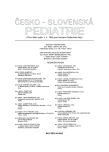Experience in the Monitoring of Maternal and Neonatal Iodine Supply in the Czech Republic
Authors:
O. Hníková 1; F. Delange 2; P. Kračmar 3; H. Vinohradská 4; R. Bílek 5
Authors‘ workplace:
Department of Pediatrics, University of Brussels, Brussels, Belgium
2; Neonatal Screening Center, Prague, Czech Republic
3; Department of Pediatrics, Charles University, rd Medical Faculty, Prague, Czech Republic
3; Neonatal Screening Center, Brno, Czech Republic
4; Institute of Endocrinology, Prague, Czech Republic
5
Published in:
Čes-slov Pediat 2005; 60 (1): 3-6.
Category:
Original Papers
Overview
The Czech Republic (CR) used to be affected by iodine deficiency. Iodization of table salt was introduced as a prophylactic measure in 1947 using potassium iodide (KI) at 12 parts per million (ppm). This level was increased to 27–42 ppm in 1996 together with a program of systematic supplementation of pregnant women with a daily tablet containing 100 μg KI. The change in the program resulted in a complete correction of iodine deficiency in the adult population since 2000, as assessed by the level of urinary iodine. The present study concentrated on the most at-risk groups to the effects of iodine deficiency, namely pregnant women and neonates. It evaluated the effects of the changes in the program of correction of iodine deficiency on urinary iodine of mothers and their neonates and on neonatal TSH in the national program of systematic screening for congenital hypothyroidism.
Urinary iodine was determined in 50 mother-neonate pairs on the fifth day after delivery in three areas of CR in 1993–1995 and in two of them in 1997 (before and after the changes in the program, respectively). Neonatal TSH was determined in 737 776 newborns screened between 1996 and 2003.
In 1993–1995 the median urinary iodine values in the mothers (29–72 μg/L) and in the neonates (28–77 μg/L) were almost similar and indicated mild to moderate iodine deficiency. In both groups they slightly increased after the improvement of the iodine program (58–79 μg/L) but remained below 100 μg/L. The recall rate of neonates under suspicion of congenital hypothyroidism progressively decreased from 0.7 % in 1996 to < 0.1 % in 2000 but the frequency of neonatal TSH above 5 mU/L remained above the cut-off point of 3 % up to 2002. In conclusion, in spite of the fact that the CR has achieved iodine sufficiency in the general population, the status of iodine nutrition of pregnant mothers and neonates remained insufficient without special preventive measures, with possible functional consequences in the thyroid function of the offspring. The study confirms that neonatal thyroid screening is a particularly sensitive monitoring tool for the evaluation of the degree and of the correction of iodine deficiency.
Key words:
iodine deficiency, urinary iodine, pregnancy, neonatal thyroid screening
Labels
Neonatology Paediatrics General practitioner for children and adolescentsArticle was published in
Czech-Slovak Pediatrics

2005 Issue 1
Most read in this issue
- Sad Facies, Spinal Malsegmentation, Progressive Vicious Kyphoscoliosis, Multiple Wormian Bones, Basilar Impression – A Novel Syndrome. Report of Two Sisters
- Genetic Polymorphisms of UGT 1A1*28 in the TATA-box Promoter Region of Bilirubin Uridinediphosphate-glucuronosyltransferase Gene in Children with Gilbert’s Syndrome
- Vascular Anomalies in Children – a New Classification System, Natural History and Treatment
- Unique Pattern Syndrome of Distinctive Facies, Short Stature, Kyphoscoliosis, Craniosynostosis, Hyperlaxity and Dyslexia
